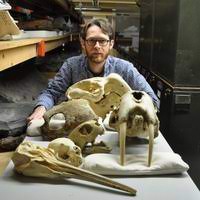Prof. Neil Kelley’s recent paper was featured in this week’s episode of Shortwave, a science podcast produced by NPR


Summary
Marine tetrapods occupy important roles in modern marine ecosystems and often gather in large aggregations driven by patchy prey distribution,1,2 social or reproductive behaviors,3,4 or oceanographic factors.5 Here, we show that similar grouping behaviors evolved in an early marine tetrapod lineage, documented by dozens of specimens of the giant ichthyosaur Shonisaurus in the Luning Formation in West Union Canyon, Nevada, USA.6,7 A concentration of at least seven skeletons closely preserved on a single bedding plane received the bulk of previous attention. However, many more specimens are preserved across ∼106 square meters and ∼200 stratigraphic meters of outcrop representing an estimated >105–6 years. Unlike other marine-tetrapod-rich deposits, this assemblage is essentially monotaxic; other vertebrate fossils are exceptionally scarce. Large individuals are disproportionately abundant, with the exception of multiple neonatal or embryonic specimens, indicating an unusual demographic composition apparently lacking intermediate-sized juveniles or subadults. Combined with geological evidence, our data suggest that dense aggregations of Shonisaurus inhabited this moderately deep, low-diversity, tropical marine environment for millennia during the latest Carnian Stage of the Late Triassic Period (237–227 Ma). Thus, philopatric grouping behavior in marine tetrapods, potentially linked to reproductive activity, has an antiquity of at least 230 million years.
The article was featured on the cover of Current Biology (Volume 32, Issue 24, 19 December 2022)
The paper is:
https://doi-org.proxy.library.vanderbilt.edu/10.1016/j.cub.2022.11.005